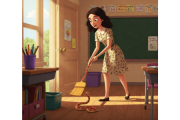The second year students, our Big Sisters, had told us stories about their experiences with Miss Staczs during their rotations on Obstetrics (OBS). None of those nasty stories made my mood any lighter, but what could I really do besides grit my teeth and get through it? The only thing I felt happy about was that at least I didn’t have to face her alone. I would be part of a group of five students assigned to OBS for the entire fourteen weeks. I prayed for safety in numbers.
In our first classroom experience, Miss Staczs pompously presented her credentials to us. She’d been a Registered Nurse in her home country, she said, and had continued on in post graduate studies to become a midwife. She’d spent several years practicing midwifery in soon-to-be mothers’ homes, coaching them through their many hours of labour and then, independently delivering their babies. As a matter of course, she’d continued overseeing each mother’s recovery and the child’s early development, assisting mother to successfully breast feed her infant. With obvious disdain, she announced that she was not entitled to work as a midwife in Ontario as the practice of midwifery was not sanctioned by the province. Midwifery was not proclaimed an authorized health care profession in Ontario until 1993.
Throughout our classroom time, Miss Staczs combined her lectures with personal anecdotes from her career. We repeatedly heard about the many babies she had single handedly delivered in the mothers’ homes. She considered any non-natural interventions such as epidural anesthesia, forceps deliveries, or bottle fed babies, to be heresy. Insisting that breastfeeding was the only acceptable way to feed a newborn, she was highly dismissive of the majority of new mothers who chose instead to bottle feed their infants.
In the late 1960s and early 70s, women in labour were admitted to the OBS Labour Room where they were attended by a Registered Nurse (RN) throughout their entire labour. The RN was responsible for the safety of both mother and baby. Her role was to assess the mother’s stage of labour, determine her level of pain, the status of the unborn child, and to communicate her assessment to the doctor. She would continue to update the physician by phone as the patient’s labour progressed or if medical intervention was required for either mother or baby. Physicians were not typically present in the hospital during the mother’s labour and usually waited til the last possible moment to arrive at the hospital to deliver the baby. It was the nurse’s responsibility to contact him* at the precise moment that would ensure he’d arrive just in time so as to minimally interfere with the rest of his schedule. Woe to the nurse who called him to the hospital too early and wasted his time. As a student, I was told I would learn all these skills. It felt overwhelming to me; I panicked about what seemed such a huge responsibility.
*During my entire three years of training, I never encountered a female physician.




